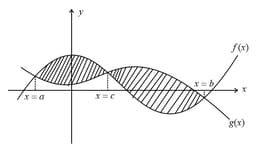The curve passes through the point and its tangent at origin is the line The area bounded by the curve, the abscissa of the curve at minima and the tangent line is:

Important Points to Remember in Chapter -1 - Area of Bounded Regions from Amit M Agarwal Skills in Mathematics for JEE MAIN & ADVANCED INTEGRAL CALCULUS Solutions
1. Area Under the Curve:
(i) Area bounded by the curve , -axis and the ordinates and is given by
.
(Note: Here, modulus is used because of the convention to consider the magnitude of area only, whether is below or above the -axis.)
(ii) Area bounded by the curve , -axis and abscissa is given by
.
2. Area Bounded by Curves:
Area bounded between the curves and from to is given by
, Now use the property , wherever it is required to define the modulus.

For example-Shaded area in the above diagram is
3. Curve Tracing:
To find approximate shape of a curve, the following phrases are suggested:
(i) Symmetry:
(a) Symmetry about -axis:
If all the powers of '' in the equation are even then the curve (graph) is symmetrical about the -axis.
E.g.:
(b) Symmetry about -axis:
If all the powers of '' in the equation are even then the curve (graph) is symmetrical about the '' -axis.
E.g.:
(c) Symmetry about both axis:
If all the powers of '' and '' in the equation are even then the curve (graph) is symmetrical about the '' as well as '' -axis.
E.g.:
(d) Symmetry about the line
If the equation of the curve remain unchanged on interchanging '' and '' then the curve (graph) is symmetrical about the line
E.g.:
(e) Symmetry in opposite quadrants:
If the equation of the curve (graph) remain unaltered when '' and '' are replaced by and respectively, then there is symmetry in opposite quadrants.
(ii) Find the points where the curve crosses the -axis and the -axis.
(iii) Find and equate it to zero to find the points on the curve where you have horizontal tangents.
(iv) Examine intervals when is increasing or decreasing.
(v) Examine what happens to '' when or
